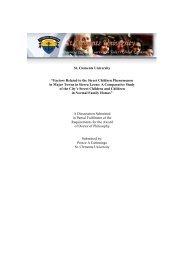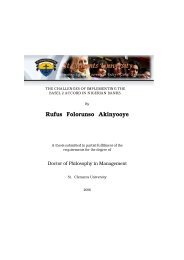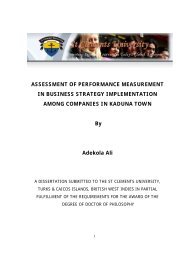The role of informal microfinance institutions in saving
The role of informal microfinance institutions in saving
The role of informal microfinance institutions in saving
You also want an ePaper? Increase the reach of your titles
YUMPU automatically turns print PDFs into web optimized ePapers that Google loves.
2.2.2: Empirical studies from outside Tanzania<br />
In its study, Development International Desjard<strong>in</strong>s (2005) f<strong>in</strong>ds that the motives beh<strong>in</strong>d the<br />
formation <strong>of</strong> sav<strong>in</strong>gs and credit Cooperatives societies (SACCOs) depended on the premises<br />
and an approach to cooperatives challenges. <strong>The</strong>se <strong>in</strong>volved the <strong>in</strong>volvement <strong>of</strong> the respective<br />
Africa countries to spear head the formation <strong>of</strong> sav<strong>in</strong>gs and credit cooperatives societies<br />
(SACCOs) and the <strong>in</strong>volvement <strong>of</strong> non-Africa promoters who provided either f<strong>in</strong>ancial or<br />
consultative services to the formation <strong>of</strong> sav<strong>in</strong>gs and credit cooperatives societies (SACCOs) <strong>in</strong><br />
various Africa.<br />
<strong>The</strong> study further f<strong>in</strong>ds that the autonomous SACCOs based on sav<strong>in</strong>gs mobilization prior to<br />
grant<strong>in</strong>g loans are <strong>of</strong> recently, be<strong>in</strong>g established <strong>in</strong> Burk<strong>in</strong>a Faso, Cameroon, Zaire (Democratic<br />
Republic <strong>of</strong> Congo), Rwanda, Ben<strong>in</strong> and Ivory Coast <strong>in</strong> 1970, <strong>in</strong> Tanzania <strong>in</strong> 1938(<strong>in</strong> Moshi<br />
Town).<br />
<strong>The</strong> major comparative advantages <strong>of</strong> credit unions lie <strong>in</strong> their ability to service large number<br />
<strong>of</strong> depositors, and use these sav<strong>in</strong>gs to provide a diversified range <strong>of</strong> loans to <strong>in</strong>dividual<br />
members. Other key strengths are their ability to susta<strong>in</strong>able achieve a large breadth <strong>of</strong><br />
outreach, and also considerable depth as suggested by median sav<strong>in</strong>gs deposit and loan size<br />
and its distribution <strong>in</strong> several countries such as Bolivia, Ecuador, Philipp<strong>in</strong>es, and Sri Lanka<br />
(Branch and Evans), 1999; Evans, 2001).<br />
Government <strong><strong>in</strong>stitutions</strong> have <strong>of</strong>ten misused the cooperative movement for political purposes.<br />
In fact, government <strong>in</strong>terference is a major cause <strong>of</strong> cooperative failure- especially <strong>in</strong><br />
develop<strong>in</strong>g countries. Cooperative performance <strong>in</strong> rural areas is mixed (Braver man and<br />
Guasch, 1989; Huppi and Feder, 1990), and a change <strong>in</strong> the regulatory and supervisory<br />
framework as well as technical assistance is <strong>of</strong>ten called for to improve performance.<br />
Krahnen and Schmidt (1994) assert that the ownership and governance structure <strong>of</strong> credit<br />
unions tends to favor depositors over the <strong>in</strong>terests <strong>of</strong> owners and borrowers, lead<strong>in</strong>g to a<br />
safety-oriented policy that sacrifices pr<strong>of</strong>itability and efficiency. However, under the risky<br />
conditions <strong>of</strong> rural areas <strong>in</strong> develop<strong>in</strong>g countries, this conservative policy can <strong>in</strong>deed be risk-<br />
efficient <strong>in</strong> the eyes <strong>of</strong> risk-averse depositors and low-<strong>in</strong>come owners. Krahnen and Schmidt<br />
112
















